Networker (train)
The Networker is a family of trains which operate on the UK railway system. They were built in the late 1980s and early 1990s by British Rail Engineering Limited (which became part of ABB in the 1990s). The trains were built for the Network SouthEast sector of British Rail, which is where their name comes from. They are all multiple-unit trains.
| Networker | |
|---|---|
A Class 165 at Reading in Great Western Railway livery | |
| In service | 1990–present |
| Manufacturer | |
| Number built | 344 trainsets |
| Operator(s) |
|
| Specifications | |
| Maximum speed | 75–100 mph (121–161 km/h) |
| Track gauge | 1,435 mm (4 ft 8 1⁄2 in) standard gauge |
The Networker design was to become effectively the third generation of British Rail multiple units, and was originally intended to become one of the largest families of trains, bigger even than the largely Mark 3-based Second Generation. The design was supposed to cover all requirements for future NSE multiple units; however, the poor state of the economy in the early 1990s prevented this from happening.
Subsequently, Bombardier Transportation used the Networker as the basis for its successful post-privatisation Turbostar and Electrostar units, having obtained the design through its acquisition of ADtranz which had absorbed ABB.
DMUs
Since the privatisation of British Rail, many of the new train operating companies have purchased Turbostar trains from Bombardier Transportation (formerly ADtranz), which are derived from the Networker-turbo design.
Class 165
The Class 165 is a 2 and 3 car Diesel multiple unit (DMU), built for outer suburban workings. Upon privatisation, Chiltern Railways and Thames Trains operated the class. Chiltern still uses the class, whilst Thames Trains have been replaced by First Great Western Link, and in turn First Great Western. The Class 165/0 batch are one of the few units in Britain to have ATP installed.
Class 166
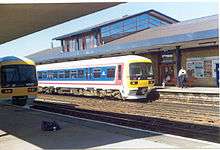
The Class 166 is a 3 car Diesel multiple unit (DMU), built for mainline workings. This class is also related to the Turbo family of trains. Used by Network SouthEast, upon privatisation Thames Trains (replaced by First Great Western Link, now First Great Western). 21 units of the class were built between 1992 and 1993.
EMUs
Classes 316 and 457
These designations applied to a single four-car EMU that was used as a research prototype. Class 457 was assigned for the tests using third-rail DC traction, following which it was converted to test AC OHLE traction and renumbered as Class 316.
Class 365
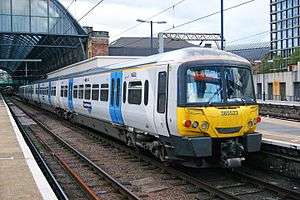
The Class 365, occasionally referred to as the "happy train" due to the design of its cab air conditioning system, is a 4-car Electric Multiple Unit (EMU). Although capable of dual-voltage operation, they have only been used in single-voltage mode. They were initially supplied with only pick-up shoes[1] for use with 750 V DC via third rail to Network SouthEast, which became Connex South Eastern upon privatisation, and then South Eastern Trains when the franchise changed. They were then transferred to WAGN (now Govia Thameslink Railway) where the shoe gear was removed and a Brecknell Willis high speed pantograph was fitted for use with 25 kv AC overhead line equipment. 41 units of the class were built between 1994 and 1995.[2]
Class 465
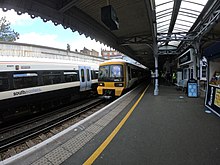
The Class 465 is a 4-car Electric Multiple Unit (EMU), powered from 750 V DC third rail. Built by British Rail Engineering Limited (465/0), ABB (465/1) and Metro Cammell (465/2) in slightly different versions. Later some of the Metro Cammell units received an internal overhaul and a first-class section was added; these were numbered 465201-465234 and are now numbered 465901-465934 and are known as Weald units. Used by Network SouthEast, then Connex South Eastern upon privatisation, succeeded by South Eastern Trains and currently Southeastern.
Class 466
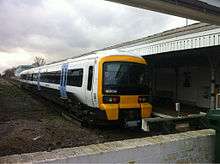
The Class 466 is a 2-car Electric Multiple Unit (EMU). It is powered from 750 V DC third rail and used extensively in multiple with 4-car 465s to provide 6-car and 10-car formations. They were built by Metro Cammell (who built the 465/2s) and powered by GEC traction. The 466s are numbered 466001-466043. The arrival of new Electrostar (class 376/0) stock has seen some units move to rural lines to operate 2-car shuttles, displacing half the Class 508s. Used by Network SouthEast, then Connex South Eastern upon privatisation, succeeded by South Eastern Trains and currently Southeastern. 43 units of the class were built between 1993 and 1994.
Proposals
Class 341 and 342
Class 341 and 342 were EMU types that were proposed but never built. Class 341 was intended to be the rolling stock for Crossrail prior to its cancellation in the early 1990s; the specifications for this class were later used in drawing up the rolling stock specifications for the current incarnation of Crossrail. Class 342 was intended for use on domestic services using the Channel Tunnel Rail Link when it opened in 1994. In the end these services were abandoned, and no trains were constructed.[3]
Class 371, 381 and 471
Class 371, 381 and 471 were three further EMU types intended as part of the Networker series. Classes 371 and 381 were proposed as the "Universal Networker", a dual voltage train type for a multitude of services including Kent Coast, Great Northern, Thameslink and LTS routes. Class 471 was the proposed "main line Networker" intended for long-distance services from London to Kent and Sussex.
Variants
| Class | Image | Operator | Introduced | Number | Carriages | End Gangways | Car Length | Notes |
|---|---|---|---|---|---|---|---|---|
| Diesel Multiple Units | ||||||||
| 165 | Chiltern Railways | 1990-1992 | 39 | 2 or 3 | No | 22 m (74 ft 6 in) | ||
| ||||||||
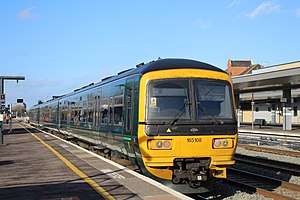 |
Great Western Railway | 1992 | 36 | 2 or 3 | No | 22 m (74 ft 6 in) | ||
| ||||||||
| 166 | 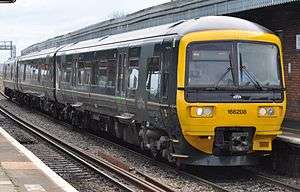 | 1992-1993 | 21 | 3 | No | 22 m (74 ft 6 in) | ||
| Dual-Voltage | ||||||||
| 316 and 457 | British Rail | 1989-1990 | 1 | 4 | Yes | This was the prototype of the Networkers, initially as the 316 and then converted to the 457. | ||
| 371, 381 and 471 | Never Built | Yes, 471 only | Proposed electric multiple unit classes from the Networker family of trains intended to operate services in the south-east of England. | |||||
| Pantograph | ||||||||
| 341 and 342 | Never Built | No | This was designed for BR's Crossrail but then the design, like the original Crossrail plan, was dropped. | |||||
| 365 |  | Great Northern | 1994-1995 | 41 | 4 | 20 m (65 ft 9 in) | Remaining vehicles of 365 526 stored out of use after Potters Bar rail accidents. | |
| Contact Shoe | ||||||||
| 465 |  | Southeastern | 1991-1994 | 147 | 4 | No | 20 m (65 ft 9 in) | |
| 466 | 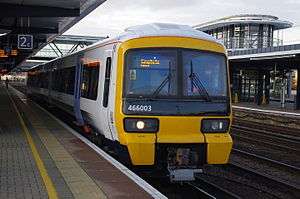 | 1993-1994 | 43 | 2 | No | 20 m (65 ft 9 in) | ||
References
- Connex South Eastern: Train Operating Manual Classes 365,465,466. p.A.9 (Class 365 Unit Formation) January 1998. Retrieved 2011-02-14
- Class 365 Electric Multiple Unit - Eversholt Rail Group. Retrieved 2013-04-09.
- "Part 4: Electric Multiple Units" (PDF). TheRailwayCentre.com. 2 May 2006. Archived from the original (PDF) on 7 February 2012. Retrieved 5 November 2015.